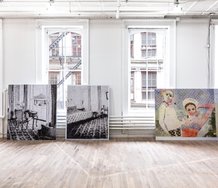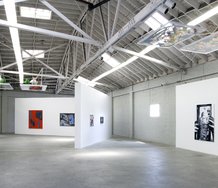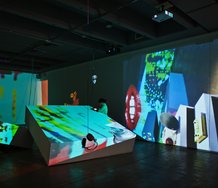Laura Brown – 18 January, 2013
Indeed the seventh APT's engagement with this archive through the exhibition and online space suggest a rethinking of the use of an archive itself, beyond how we might typically think of a kind of store of information in a ‘cool, dry place'. Rather, it was occupied as a live site which, manipulated correctly, may become active beyond the benign past.
Brisbane
QAG and GoMA
The Seventh Asia Pacific Triennial of Contemporary Art
8 December 2012 - 14 April 2013
This year the Asia Pacific Triennial celebrates its twentieth year - a fact emphasised many times over across promotional material and in conversation amongst visitors, and reason alone for many visitors from other cities and countries during the exhibition’s opening weekend. Along with this, as with any recurring large exhibition, a sense of freshness and curiosity comes in a desire to engage with the latest discourse, which is emphatically the case as this exhibition is lionised as the ‘only major exhibition series in the world to focus on the contemporary art of Asia, the Pacific and Australia’(1).
The APT series itself serves as an excellent archive of developments across the region as well as, perhaps even more precisely, a means to map the development of the Queensland Art Gallery and the newer Gallery of Modern Art - with each exhibition hailed as the more ambitious and comprehensive than the one before. The question is how the format of the exhibition, along with its many accompanying parts, may be used to reappraise this significant archive in a way that holds its own merit beyond what would already indexically be available to those interested enough to do their own research.
Indeed the seventh APT’s engagement with this archive through the exhibition and online space suggest a rethinking of the use of an archive itself, beyond how we might typically think of a kind of store of information in a ‘cool, dry place’. Rather, it was occupied as a live site which, manipulated correctly, may become active beyond the benign past.
The answer is the 20-Year Archive, both a part of the exhibition and with a dedicated website. The Archive brings in artists, curators, writers, and other groups to exploit the anniversary as an opportunity for a mapping and re-mapping of the APT archive, the Gallery’s Asia Pacific Art (AGAPA) archive, and archives across the region.
A room shrouded in red light, accessible through a hole literally smashed through the wall, obscures the entrance to the gallery’s library. Stepping through its jagged mouth, the room draws audience members to its edges, as hidden speakers play voices reciting snippets of passages, or lists of words. Towards the back of the room the floor rises and then falls again, giving the impression of having taken a small journey as one must climb its gentle slope to travel the full circuit of the room. For this sound installation, Heman Chong (an artist as well as writer and curator) has sifted through texts found in the ACAPA archive to create what Chong pronounces an ‘epic poem’.
This poem, spoken and repeated across the room rather than written or read, sounds as if it were made up of fragments from a kind of hallucinatory conversation between art world academics or curators - or a very confused press release, nonetheless containing all the necessary descriptives, historical references, and dates. This brings to mind the essay published earlier this year by New York group Triple Canopy titled International Art English, which documents and dissects the workings of the distinct language that has come to circulate amongst the internationalised art world (perhaps most readily witnessed in your daily flurry of e-flux press releases (2)).
Indeed a work like this allows for shifting associations depending on the audience, which brings me to wonder what links might be made for those outside of the art world. The work serves well as a means of explaining, in an adventurous and slightly self-depreciating tone, how the archive has communicated across the two decades. Though what might a less specific audience make of this? Perhaps the experience of stepping into this strange red room along with the odd snippets of speech makes for an intriguing kind of live library, quite different to the adjacent literal one which, far more coldly, is not open to the general public without special appointment.
Beyond the Archive, there were many notable works which hold strong on their own and complement their accompanying works. On the ground floor, around a corner, into a dark room, and up a short flight of stairs lay Tadasu Takamine’s multimedia installation, which viewers looked down into from an elevated platform. This installation held a remarkably poetic way of communicating, with what seemed like its own unique language in a combination of light, sound, music, text, and kinetic sculpture, to draw the audience along its narrative path. In the aftermath of recent disasters in both Japan and Australia, Takamine traverses a landscape of loss, memory, and place in suggesting the consequences of abandoning possessions that go far beyond material belongings.
With a similarly distinct vocabulary that exceeds those usually bound with geography, Basir Mahmood’s videos observe the variances in class and social identities by meditating upon everyday life and its oft monotonous activities. We observe an unaware man, in close-up detail, trying and failing over and over to thread a needle. Another work watches from afar, in slow motion, strangers trying on second hand clothing in an open air street market. A clarity shines through in Mahmood’s ability to emphasise a sense of humanity and humility between us and the unknown person before us; a calming consideration of the subject despite the frustration evident in the activity itself.
With a sense of freshness in its revisiting of the past, this APT offers considerably more than the format of the exhibition might suggest. In considering the exhibition itself, the more successful points are those where works are allowed ample space for each to hold its own voice in a conversation with participants so far-reaching geographically and, as a result, so diverse and distinct in expression.
Footnotes
(1.) Online at http://www.qagoma.qld.gov.au/apt7, and as quoted many times across the exhibition’s promotional material.
(2.) Rule, A & Levine, D 2012, International Art English, Triple Canopy, Issue 16.
Laura Brown
This is the first of three reviews of The Seventh Asia Pacific Triennial - a partnership with Ocula



 Two Rooms presents a program of residencies and projects
Two Rooms presents a program of residencies and projects Advertising in this column
Advertising in this column



This Discussion has 0 comments.
Comment
Participate
Register to Participate.
Sign in
Sign in to an existing account.